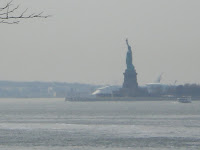



March 27, 2009 - Group Walk to the Irish Hunger Memorial
In honor of St. Patrick's Day, the Memorial Miles team members Michael Prince, Anita London, Malik Goodson, Kamran Khan, Clarelle De Graffe, Barbara Carreiro, Tom Grassi, Remaro Chambers, Joan Hamilton and Paul Pietropaolo took their March monthly group walk to The Irish Hunger Memorial garden which is located on the corner of 290 Vesey and North End Avenue. The memorial garden is a beautiful example of outdoor art in New York City. The weather managed to cooperate with the cold spring rain holding off until after the group had completed the walk.
The Irish Hunger Memorial (or Irish Famine Memorial), the creation of artist Brian Tolle, is devoted to raising public awareness of the events that led to the "Great Irish Famine and Migration" of 1845-1852. It serves as a reminder to millions of New Yorkers and Americans who proudly trace their heritage to Ireland, of those who were forced to emigrate during one of the most heartbreaking tragedies in the history of the world. The Great Hunger" began in 1845 when a blight destroyed the Irish potato crop, depriving Ireland of its staple food. By 1847 millions were starving and dying. Between 1847 and 1852 hundreds of thousands of Irish immigrated to New York where they arrived at South Street Seaport and Castle Clinton. Today, almost 800,000 New York City residents trace their ancestry to Ireland. The Irish Hunger Memorial (which takes its name from the Irish term for the famine of 1845-52, "An Gorta Mor," The Great Hunger) stands on a half-acre site at the corner of Vesey Street and North End Avenue in Battery Park City, between the Embassy Suites Hotel and the Hudson River. The 96' x 170' Memorial, which contains stones from each of Ireland's 32 counties, is elevated on a limestone plinth. Along the base are bands of texts separated by layers of imported Kilkenny limestone. The limestone is more than 300 million years old and contains fossils from the ancient Irish seabed. The text, which combines the history of the Great Famine with contemporary reports on world hunger, is cast as shadow onto illuminated frosted glass panels. From its eastern approach the Memorial appears as a sloping landscape with a pathway inviting visitors to walk upward past a ruined fieldstone cottage and stone walls toward a pilgrim's standing stone. At the western end of the Memorial, 25 feet above the pavement, a cantilevered overlook offers views of the Statue of Liberty and Ellis Island, emblems of America's welcome to the Irish and to all immigrant people.
From the western or river end, the visitor approaches the Memorial through a formal ceremonial entrance that recalls the court cairn or graves of the Irish Neolithic period that are found in the Irish northwest. The ramped passageway ends inside the ruined fieldstone cottage that was brought to New York from the townland of Carradoogan near Attymass, County Mayo.
The size of the cultivated area of the Memorial, one-quarter of an acre, is significant. In 1847, Sir William Gregory proposed an additional clause to the Irish Poor Law stipulating that no person occupying land of more than one-quarter acre was eligible for any relief. This law had a devastating effect and contributed to the suffering. The unroofed abandoned cottage reminds the visitor of the stark choice between survival and holding home and hearth.































No comments:
Post a Comment